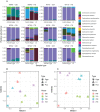Comparison of two molecular barcodes for the study of equine strongylid communities with amplicon sequencing
- PMID: 37070089
- PMCID: PMC10105562
- DOI: 10.7717/peerj.15124
Comparison of two molecular barcodes for the study of equine strongylid communities with amplicon sequencing
Abstract
Basic knowledge on the biology and epidemiology of equine strongylid species still needs to be improved to contribute to the design of better parasite control strategies. Nemabiome metabarcoding is a convenient tool to quantify and identify species in bulk samples that could overcome the hurdle that cyathostomin morphological identification represents. To date, this approach has relied on the internal transcribed spacer 2 (ITS-2) of the ribosomal RNA gene, with a limited investigation of its predictive performance for cyathostomin communities. Using DNA pools of single cyathostomin worms, this study aimed to provide the first elements to compare performances of the ITS-2 and a cytochrome c oxidase subunit I (COI) barcode newly developed in this study. Barcode predictive abilities were compared across various mock community compositions of two, five and 11 individuals from distinct species. The amplification bias of each barcode was estimated. Results were also compared between various types of biological samples, i.e., eggs, infective larvae or adults. Bioinformatic parameters were chosen to yield the closest representation of the cyathostomin community for each barcode, underscoring the need for communities of known composition for metabarcoding purposes. Overall, the proposed COI barcode was suboptimal relative to the ITS-2 rDNA region, because of PCR amplification biases, reduced sensitivity and higher divergence from the expected community composition. Metabarcoding yielded consistent community composition across the three sample types. However, imperfect correlations were found between relative abundances from infective larvae and other life-stages for Cylicostephanus species using the ITS-2 barcode. While the results remain limited by the considered biological material, they suggest that additional improvements are needed for both the ITS-2 and COI barcodes.
Keywords: Cyathostomin; Cytochrome c oxidase subunit I; Horse; Internal transcribed spacer 2; Mitochondrial; Nematode; Parasite; Ribosomal; Strongylid.
© 2023 Courtot et al.
Conflict of interest statement
The authors declare that they have no competing interests.
Figures



Similar articles
-
Faecal egg counts and nemabiome metabarcoding highlight the genomic complexity of equine cyathostomin communities and provide insight into their dynamics in a Scottish native pony herd.Int J Parasitol. 2022 Nov;52(12):763-774. doi: 10.1016/j.ijpara.2022.08.002. Epub 2022 Oct 5. Int J Parasitol. 2022. PMID: 36208676
-
Prevalence, risk factors, and species diversity of strongylid nematodes in domesticated Thai horses: insights from ITS-2 rDNA metabarcoding.Parasitol Res. 2024 Dec 17;123(12):410. doi: 10.1007/s00436-024-08438-0. Parasitol Res. 2024. PMID: 39688721
-
Metabarcoding study to reveal the structural community of strongylid nematodes in domesticated horses in Thailand.BMC Vet Res. 2024 Feb 24;20(1):70. doi: 10.1186/s12917-024-03934-y. BMC Vet Res. 2024. PMID: 38395874 Free PMC article.
-
Coming of age for COI metabarcoding of whole organism community DNA: Towards bioinformatic harmonisation.Mol Ecol Resour. 2022 Apr;22(3):847-861. doi: 10.1111/1755-0998.13502. Epub 2021 Sep 30. Mol Ecol Resour. 2022. PMID: 34496132 Free PMC article. Review.
-
DNA barcoding, an effective tool for species identification: a review.Mol Biol Rep. 2023 Jan;50(1):761-775. doi: 10.1007/s11033-022-08015-7. Epub 2022 Oct 29. Mol Biol Rep. 2023. PMID: 36308581 Review.
Cited by
-
Mixed strongyle parasite infections vary across host age and space in a population of feral horses.Parasitology. 2024 Oct;151(12):1299-1316. doi: 10.1017/S0031182024001185. Epub 2024 Dec 12. Parasitology. 2024. PMID: 39663810 Free PMC article.
-
Nemabiome sequencing reveals seasonal and age associated patterns of strongyle infection and high prevalence of Strongylus vulgaris in Alberta feral horses.Int J Parasitol Parasites Wildl. 2025 May 28;27:101091. doi: 10.1016/j.ijppaw.2025.101091. eCollection 2025 Aug. Int J Parasitol Parasites Wildl. 2025. PMID: 40524829 Free PMC article.
-
Gastrointestinal nematodes in German outdoor-reared pigs based on faecal egg count and next-generation sequencing nemabiome data.Porcine Health Manag. 2024 Sep 12;10(1):33. doi: 10.1186/s40813-024-00384-8. Porcine Health Manag. 2024. PMID: 39267163 Free PMC article.
-
Changes in equine strongylid communities after two decades of annual anthelmintic treatments at the farm level.Parasitol Res. 2024 Nov 25;123(11):394. doi: 10.1007/s00436-024-08417-5. Parasitol Res. 2024. PMID: 39585485 Free PMC article.
References
-
- Ang L, Vinderola G, Endo A, Kantanen J, Jingfeng C, Binetti A, Burns P, Qingmiao S, Suying D, Zujiang Y, Rios-Covian D, Mantziari A, Beasley S, Gomez-Gallego C, Gueimonde M, Salminen S. Gut microbiome characteristics in feral and domesticated horses from different geographic locations. Communications Biology. 2022;5(1):172. doi: 10.1038/s42003-022-03116-2. - DOI - PMC - PubMed
-
- Avramenko RW, Redman EM, Lewis R, Yazwinski TA, Wasmuth JD, Gilleard JS. Exploring the gastrointestinal “nemabiome”: deep amplicon sequencing to quantify the species composition of parasitic nematode communities. PLOS ONE. 2015;10(12):e0143559. doi: 10.1371/journal.pone.0143559. - DOI - PMC - PubMed
Publication types
MeSH terms
Substances
LinkOut - more resources
Full Text Sources

